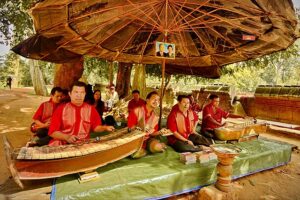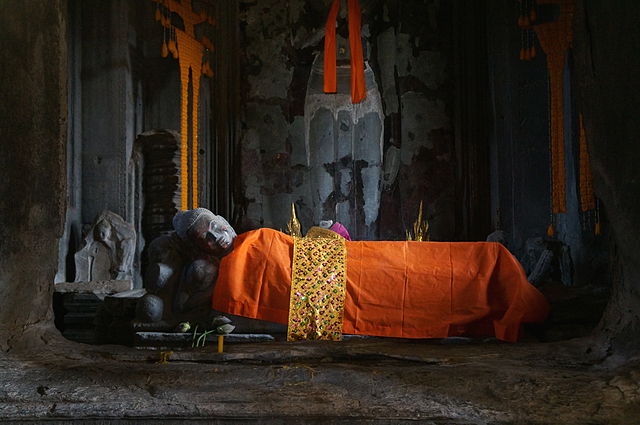
Angkor Wat, tourists at sunset, Photo Gerd Eichmann, 1 February 2007, CCA-SA 4.0 International license.
Despite continuing controversy regarding the Cambodian government’s forced eviction and relocation of 40,000 people from traditional villages around Angkor Wat, the World Monuments Fund (WMF) announced the transfer of full responsibility for preservation of three key sites within the Angkor Archaeological Park in Cambodia to a Cambodian government agency, the Authority for the Protection and Management of Angkor (APSARA National Authority) on January 30, 2024. While conservation work on other sites will be completed by the WMF including ongoing conservation efforts at Phnom Bakheng II, APSARA is assuming full management of Ta Som and Preah Khan Temples, as well as the Churning of the Ocean of Milk Gallery in Angkor Wat.
The announcement was made at a ceremony honoring 35 years of World Monuments Fund work at Angkor Wat, a World Heritage Monument of international status. The WMF began conservation work at Angkor Wat in 1989 and APSARA was established in 1995. WMF has focused on capacity-building work, physical conservation and skills development for its Cambodian partners. However, without in any way criticizing the dedication and commitment of the professionals and conservationists in training at APSARA, the transfer does leave the management of some of the most important monuments within Angkor Wat without an international organization in a key role as administrative partner. The transition to the APSARA National Authority as exclusive manager of these sites leaves decision-making regarding the future of Angkor Wat and its development as a tourist site unambiguously in the hands of the Cambodian government.

Hun Sen and his wife pray at Angkor Wat ceremony, 2017, Voice of America screenshot, public domain.
In Cambodia, heritage is not primarily about preservation. Instead, it serves as a key tool for maintaining political power, driving development and obtaining economic and diplomatic advantages, despite the regime’s appalling international reputation as a human rights abuser. Heritage management operates within a complex web of economic and political relationships, where domestic politics and international diplomatic interests dominate. Rituals surrounding heritage continue to play a crucial role in perpetuating former Prime Minister Hun Sen’s legacy under his son and chosen heir as Prime Minister, Hun Manet.
Despite the economic benefits of preservation projects, much archaeology is neglected, and government corruption continues to facilitate smuggling of ancient art to Thailand and other east Asian destinations. A cynical form of cultural nationalism thrives, with heritage protection used to bolster the regime’s legitimacy. The involvement of foreign nations in heritage projects at Angkor validates the authority of the current regime but also serves to temper the influence of politics in preservation plans.

Photo Marcin Konsek, CCA-SA 4.0 International license.
Among the most disturbing elements of Cambodia’s heritage policy are the consequences to the local population, who many heritage professionals have described as ‘victims’ of Angkor’s transformation into one of the most famous world tourist destinations. An Amnesty International report released late last year stated that about 10,000 families in the local population at Angkor were being removed and relocated at distant resettlement sites without adequate water or sanitation facilities as part of the transformation of Angkor Wat into a much expanded tourist destination.
According to Amnesty International, the mass evictions violate international human rights law. Cambodian authorities initiated the evictions citing the need to protect the ancient site from damage. However, Amnesty’s research, based on interviews and visits to the area, indicates that authorities failed to adequately inform or consult with the affected people. Many were coerced into relocating to inadequate sites lacking basic necessities. Prime Minister Hun Sen’s warnings and threats in 2023 contributed to the sense of coercion. Residents faced intimidation and were told they risked losing their land or even imprisonment if they resisted. Despite claims that the relocation was voluntary, residents felt compelled to comply due to fear and pressure from officials. The resettlement sites do not have places to work or sufficient arable lands, forcing families to live in precarious conditions.

Traditional Musicians of Angkor, Photo Allan Jay Quesada, 12 November 2013, Creative Commons Attribution-Share Alike 4.0 International license.
The Cambodian government has denied that it removed the population of some 100 villages surrounding the World Heritage site, saying the only “squatters” had been evicted. However, residents who have lived for generations in the more than 100 villages surrounding Angkor told Amnesty International that they were threatened with imprisonment and forced to move. The promised compensation to villagers who lost their homes was delivered in the form of small plots of land, a two months’ supply of canned food, and 30 sheets of corrugated metal to build a house with per family.
Responding to international humanitarian concerns, Prime Minister Hun Manet insisted that improvements will be made and, without apparent irony, that having been given land, “they now have the status of villagers, equal to that of the traditional endogenous population settled in the Angkor zone for generations.”
UNESCO’s limited influence over member states hampers its ability to address aggressive heritage exploitation in Cambodia. Despite being aware of the situation, UNESCO failed to publicly condemned the evictions or conduct an investigation until the Amnesty International report generated worldwide condemnation. The evictions, justified in the name of conservation, raise serious concerns about the weaponization of conservation efforts by authoritarian nation states.

At Angkor Wat, 5000 Buddhist monks, plus actors, scouts, and dancers celebrated prior Cambodian Prime Minister Hun Sen’s “victory” over jailed opposition in 2017. VOA screenshot.
A response to the Amnesty International report from UNESCO’s World Heritage Center in November 2023 stated that “at no point did it request, support, or participate in this programme.” UNESCO demanded that only “voluntary” relocations be made and set a February 2024 date for an updated report from the government of Cambodia. In response, Cambodian authorities have continued to maintain that they are doing nothing more than protecting the UNESCO site from illegal squatters.
 Temple of Angkor Wat in the province of Siem Reap, Cambodia, 29 January 2014, Photo Pierre Andre Leclercq, CCA-SA 4.0 International license.
Temple of Angkor Wat in the province of Siem Reap, Cambodia, 29 January 2014, Photo Pierre Andre Leclercq, CCA-SA 4.0 International license. 

